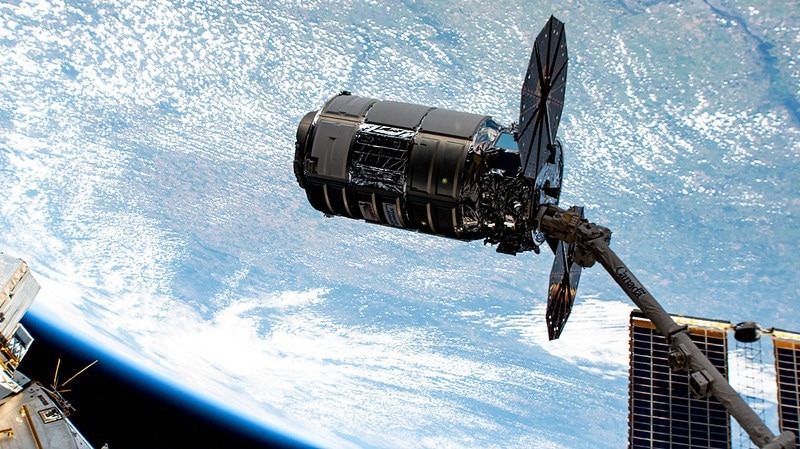Approximately 1.5 million people worldwide are affected by retinitis pigmentosa, a rare genetic disorder that causes vision loss. Currently there is no cure, but researchers from LambdaVision are turning to the International Space Station (ISS) National Laboratory to look for solutions. Through the microgravity environment of the orbiting laboratory, they aim to manufacture artificial retinas that will restore significant vision in patients with the disorder. LambdaVision will launch its ninth investigation to the space station on Northrop Grumman’s 20th Commercial Resupply Services (NG-20) mission.
 Northrop Grumman's Cygnus cargo craft is pictured after captured by the Canadarm2 robotic arm on the International Space Station in August 2023. Image Credit: NASA
Northrop Grumman's Cygnus cargo craft is pictured after captured by the Canadarm2 robotic arm on the International Space Station in August 2023. Image Credit: NASA
Led by Nicole Wagner, LambdaVision designed a layer-by-layer manufacturing process to develop a protein-based artificial retina. In 2018, the company was awarded a grant through the Technology in Space Prize, funded by Boeing and the Center for the Advancement of Science in Space™ (CASIS™), manager of the ISS National Lab, in partnership with MassChallenge, to launch its first experiment. The project kicked off an effort to leverage the microgravity environment of the space station to create higher-quality implants than is currently possible on Earth. That’s because on Earth, gravity’s effects can hinder the manufacturing process, resulting in sedimentation and reducing the amount of useable implants.
“To date, we've flown a total of eight missions to the ISS,” said Wagner. “Most of those missions have focused primarily on improving the hardware, automation, imaging capabilities, and in-orbit processes and controls.”
According to Wagner, those flights have yielded 10 test retinas, which have been returned to Earth for analysis. Now that LambdaVision has refined its manufacturing process, the company is turning its efforts to making the entire process scalable. In this investigation, the research team is examining a new method of transporting bacteriorhodopsin, the protein used in the implants, to low Earth orbit (LEO). To that end, the company will send a powdered form of the protein to the space station for testing on NG-20.
Previous flights focused on multiple aspects of production, including the layer-by-layer deposition process and analyzed the shelf-life of the protein in solution over time, to ensure there are no changes in its integrity over long periods of time in space. For this investigation, the researchers will resuspend the powdered protein in a solution as a way of testing the mixing process and ensuring quality control. Special instruments able to record absorption spectra of the solution will be used to help the researchers evaluate its purity and quality and validate the process used to get the protein into solution. These measurements will help ensure that high-quality implants can be made from raw materials in space.
Like previous LambdaVision investigations, the experiment will be housed in a Space Tango CubeLab, complete with fluidics capabilities, pumps, and cameras that will send real-time images to the ground, enabling the team to observe and monitor the whole process and intervene if necessary. It will also allow the researchers to do spectral analysis of the protein to ensure the process is sufficient by monitoring uniformity and comparing the solution to controls, which are known concentrations of protein already in solution.
“The fluidic systems and cameras that are used for imaging this time are all built on what we've learned from past experiences with the layering experiments,” said Jordan Greco, chief technology officer of LambdaVision. “The addition of the absorption spectrometer is what we're particularly excited about, as the spectrometer can tell us a lot about the quality and purity of the protein.”
Monitoring the quality over time through spectral imaging will allow the team to ensure the highest-quality implants are made, which Wagner says is the key to success. “This will help tremendously with quality assurance and will guarantee that what we’re sending up there will function in the way we intended.”
Results from this investigation will help LambdaVision scale up production to manufacture enough implants for those affected by retinitis pigmentosa. Wagner says eventually, the company hopes to scale up enough to restore sight in individuals affected by all retinal degenerative diseases, including macular degeneration, which is the leading cause of age-related blindness.
The NG-20 mission is slated to launch from Cape Canaveral Space Force Station no earlier than January 29 at 12:29 p.m. EST. This mission will include more than 20 ISS National Lab-sponsored payloads.